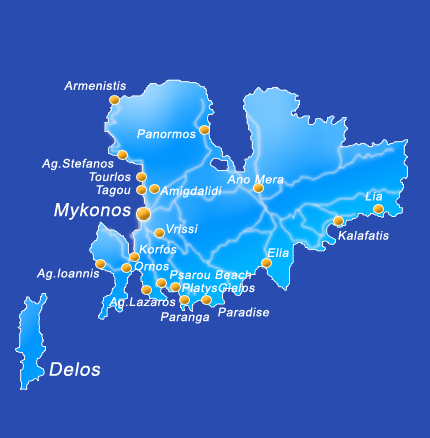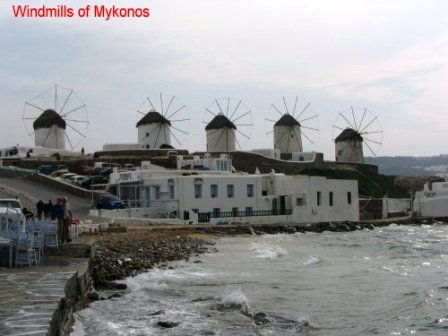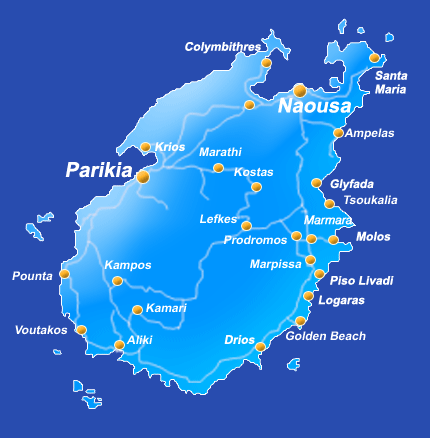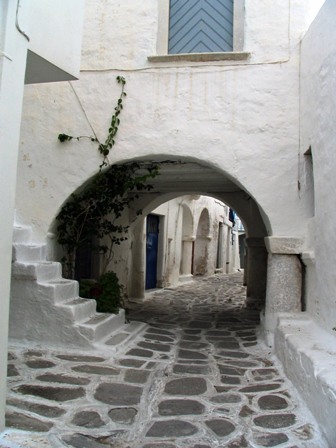| 8 October 2005 -
14 October 2005 It was time to leave Santorini. We all
got up before the sun to catch the 7:15 ferry. Ray and I
went as far as Paros, near Naxos, while the others
returned to Athens. They would spend two nights there,
with time to shop and watch the colourful changing of the
guard in front of the parliament buildings. From there
they flew to London and spent the last few days exploring
Windsor and downtown London, fitting in two Musicals.
Paros was a
welcome change. It had no visiting cruise ships and was
nice and quiet. We followed a tout, waiting at the ferry
dock, to a very nice hotel, Captain Manolis, on a quiet
back street in the port town, Parikia. Parikia has a
Kastro, the old section, with narrow shop-lined streets.
There is the ruin
of the Frankish Castle, built by the Venetian Duke of
Naxos in 1260 AD, using the remains of a temple to Athena
from the 5thC BC. All that remains are two walls, built
from the ends of marble columns and blocks, some of which
still have their original inscriptions.
The largest church
in town is the Byzantine Panagia Ekatontapylianai
Cathedral, Our Lady of the Hundred Gates, referring to
the many, but not 100, doorways. You enter through a gate
through high white walls, built as protection from
pirates, into a large garden courtyard, strewn with
marble ruins from various excavations. The stone
cathedral has a second floor balcony around three sides,
giving a good view to the main altar below with its
ornate gold chandeliers.
A German fellow, who had been staying at the hotel all
summer, had been invited to a Greek wedding that evening.
He told us that the bride would be arriving at the
Cathedral between 7 and 8 that evening, so remembering
the wedding festivities in Santorini, we were there to
await her arrival, along with many of the other guests.
Once again the groom,
clutching flowers, waited patiently outside the church.
Finally at 7:45, just before we had almost given up, car
horns announced the arrival of the bride in a spiffy red
sports car with a huge bouquet of flowers spread across
the hood. There were a few token gunpowder explosions but
not as many as the last wedding. Two small children
dressed as a ring bearer and flower girl took the bride's
train as she walked with her father to meet the groom.
All the guests walked with the couple into the church and
we went off for dinner. Our German friend told us later
that 500 guests were treated to dinner and dancing. He
left at 3 AM while others, including the bridal couple,
stayed until 6 AM.
My guidebook had recommended a restaurant in town that
featured live, traditional music on Saturday evening. We
were the only ones there for dinner before the show, but
other tourists and several locals started arriving after
9 PM. According to Greek standards, North Americans eat
far too early. We had a very good dinner and the music
was great. One woman singer and four musicians, playing a
violin, a guitar and two different sized bouzoukis took
the stage about 9:45 PM. The first violin solo sounded
just like the Cape Breton Island Celtic music. Other
tunes had African and Asian phrasings and keys. They
locals obviously liked the music and knew the songs as
they sang along to several numbers. We stayed until after
11 PM, late for us, and they were still playing.
After a breakfast of great
pastries from one of the local bakeries, we took a local
bus to Lefkes, the medieval capital of whitewashed houses
with red-tiled roofs, built on a hilltop in the center of
the island. We had to find our way through the maze of
narrow streets, built to confuse pirates, to a central
square. From there we followed infrequent markers to the
entrance to a Byzantine Road linking Lefkes with
Prodromos, 4 Km away.
It was a pleasant, quiet walk
through the countryside over flagstone and marble paved
paths.
From Prodromos we walked
uphill to another small town, Marpissa and then on to the
fishing and burgeoning resort town of Piso Livadi. We had
our picnic lunch on the wharf, watching fishermen mend
their nets and clean their catch. Logaras, a beach just
around a headland, looked inviting. We walked over,
changed into our suits and had a swim before catching the
bus back to Parakia.

Mykonos |

Click the photo of windmills
above to see an album of photos for Mykonos.
Close the window to return to this page. |
From Paros we took a 40-minute ride on a high-speed
ferry to Mykonos. Once again we chose a hotel from one of
the touts who meet the boats, with great success. Our
genial hostess, Maria, drove us from the boat to the old
section of Mykonos Town to her family-owned hotel, Studio
Eleni.
We had a good room
with bath on the rooftop for 30 Euros per day, very
reasonable for Mykonos. Maria gave us a card with a basic
map showing the location of the hotel. We needed the map.
The streets of Mykonos, like those of Lefkes on Paros,
were built to confuse pirates, and they still confuse
pirates. As well, the few street signs there are were in
Greek letters and there was neither a sign for Studio
Eleni nor a house number. By the time we left, after
inadvertently exploring almost every section of Mykonos
Town, we were getting pretty good at finding our way
around town. When we mentioned this to Maria, she
admitted people had problems. Earlier in the season she
had a young Japanese woman check in. When she didn't
return to her room that night, Maria made inquiries at
the local police station. The police admitted a young
woman had come to them seeking help getting back to her
hotel but she didn't have the hotel card with her and
didn't know the name, so the police had done nothing.
Maria searched around the waterfront restaurants the next
day until she located a very upset young lady, who had
just spent the night outside. She got to stay another
night free of charge and Maria blasted the police, of
whom there are only three on the island, for their lack
of help.
Our first day in Mykonos, a Monday, we shared the town
with a cruise shipload of tourists. They filled the
restaurants and jammed the narrow streets. What a
difference the next day when the ship had gone and the
streets were quiet again. I am afraid cruising is not our
preferred method of travel, at least not such a large
ship as those that ply the Mediterranean.
One of the main reasons for
visiting Mykonos is to take the ferry to Delos, just 3 Km
offshore. Uninhabited Delos is one of the most important
archaeological sites in Greece and was well worth a visit.
Ray and I wandered around for nearly an hour but I became
frustrated at not knowing more about what I was seeing.
Ray continued to tour on his own but I joined a small
tour group with a guide who I found very informative.
Delos was first established
as a Temple to the cult of Apollo about 1000 BC but by
the 3rd C BC became a major trading center with a
population of up to 30,000. It became very wealthy,
especially with a lucrative slave trade under the Romans
in the 2nd C BC. The island was abandoned after being
sacked by pirates in 67 BC and laid undiscovered until
French archaeologists made a deal with the Greek
government in 1873 to start studies. Nothing grows on the
island and everything had to be imported.
Because there is
no soil on the island, the original walls of the building
remained uncovered, although their wooden roofs had
disappeared. Marble statues lay strewn over the island
and mosaics that once graced the rooms of houses still
retained their colour. There are a few springs but not
enough to support the large population so an elaborate
system of cisterns and waterways was devised. After the
Athenians took control of the island, no person was
allowed to be born or die on Delos. Sick people and
pregnant woman were shipped to another island, thus
ensuring that Athenian control was maintained as no one
could claim native ties to Delos.
We returned to
Mykonos for lunch and decided we had enough time to visit
one of the island's beaches. We took the local bus to
Psarou, a protected beach just a few Km away on the south
side of Mykonos. We had our last swim in the
Mediterranean before returning to Athens the next day.
In Athens we just had time to enjoy a nice meal in the
Psirri district, a trendy restaurant and bar area near
our hotel. The next day we flew to Gatwick where we met
up with the rest of the crew. We had a good time that
evening relating our separate experiences over dinner and
beers.
We got an early morning Zoom flight to chase the sun
back to Canada. Now we have just about adjusted to the
time change once again and are not quite adjusted to the
chillier and wetter weather we are experiencing.
All in all we had a most successful trip. We saw
ancient ruins, ate great food washed down with lots of
wine and beer, visited picturesque towns and enjoyed the
clear waters of the Mediterranean. Would we go again?
Certainly, and there are lots more islands out there to
explore.
|



